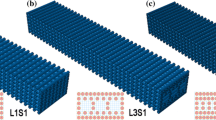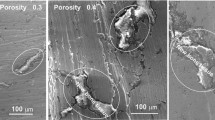Abstract
Eight groups of calcium-phosphate scaffolds for bone implantation were prepared of which seven were reinforced with biopolymers, poly lactic acid (PLA) or hyaluronic acid in different concentrations in order to increase the mechanical strength, without significantly impairing the microarchitecture. Controls were un-reinforced calcium-phosphate scaffolds. Microarchitectural properties were quantified using micro-CT scanning. Mechanical properties were evaluated by destructive compression testing. Results showed that adding 10 or 15% PLA to the scaffold significantly increased the mechanical strength. The increase in mechanical strength was seen as a result of increased scaffold thickness and changes to plate-like structure. However, the porosity was significantly lowered as a consequence of adding 15% PLA, whereas adding 10% PLA had no significant effect on porosity. Hyaluronic acid had no significant effect on mechanical strength. The novel composite scaffold is comparable to that of human bone which may be suitable for transplantation in specific weight-bearing situations, such as long bone repair.



Similar content being viewed by others
References
Hing KA. Bone repair in the twenty-first century: biology, chemistry or engineering? Philos Transact A Math Phys Eng Sci. 2004;362(1825):2821–50.
Heary RF, Schlenk RP, Sacchieri TA, Barone D, Brotea C. Persistent iliac crest donor site pain: independent outcome assessment. Neurosurgery. 2002;50(3):510–6.
Bauer TW, Muschler GF. Bone graft materials. An overview of the basic science. Clin Orthop Relat Res 2000 371:10–27.
Overgaard S, Soballe K, Josephsen K, Hansen ES, Bunger C. Role of different loading conditions on resorption of hydroxyapatite coating evaluated by histomorphometric and stereological methods. J Orthop Res. 1996;14(6):888–94.
Kim SS, Sun PM, Jeon O, Yong CC, Kim BS. Poly(lactide-co-glycolide)/hydroxyapatite composite scaffolds for bone tissue engineering. Biomaterials. 2006;27(8):1399–409.
Eshragi S, Das S. Mechanical and microstructural properties of polycaprolactone scaffolds with one-dimensional, two-dimensional and three-dimensional orthogonally oriented porous architectures produced by selective laser sintering. Acta Biomaterialia 6(7):2467–2476.
Gunatillake PA, Adhikari R. Biodegradable synthetic polymers for tissue engineering. Eur Cell Mater. 2003;5:1–16.
Gunatillake P, Mayadunne R, Adhikari R. Recent developments in biodegradable synthetic polymers. Biotechnol Annu Rev. 2006;12:301–47.
Zou L, Zou X, Chen L, Li H, Mygind T, Kassem M, et al. Effect of hyaluronan on osteogenic differentiation of porcine bone marrow stromal cells in vitro. J Orthop Res. 2008;26(5):713–20.
Pilloni A, Bernard GW. The effect of hyaluronan on mouse intramembranous osteogenesis in vitro. Cell Tissue Res. 1998;294(2):323–33.
Bastow ER, Byers S, Golub SB, Clarkin CE, Pitsillides AA, Fosang AJ. Hyaluronan synthesis and degradation in cartilage and bone. Cell Mol Life Sci. 2008;65(3):395–413.
Habibovic P, Kruyt MC, Juhl MV, Clyens S, Martinetti R, Dolcini L, et al. Comparative in vivo study of six hydroxyapatite-based bone graft substitutes. J Orthop Res. 2008;26(10):1363–70.
Hildebrand T, Ruegsegger P. Quantification of bone microarchitecture with the structure model index. Comp Methods Biomech Biomed Eng. 1997;1(1):15–23.
Ding M, Odgaard A, Danielsen CC, Hvid I. Mutual associations among microstructural, physical and mechanical properties of human cancellous bone. J Bone Joint Surg Br. 2002;84(6):900–7.
Odgaard A, Gundersen HJ. Quantification of connectivity in cancellous bone, with special emphasis on 3-D reconstructions. Bone. 1993;14(2):173–82.
Ding M, Dalstra M, Danielsen CC, Kabel J, Hvid I, Linde F. Age variations in the properties of human tibial trabecular bone. J Bone Joint Surg Br. 1997;79(6):995–1002.
Byrne DP, Lacroix D, Planell JA, Kelly DJ, Prendergast PJ. Simulation of tissue differentiation in a scaffold as a function of porosity, Young’s modulus and dissolution rate: application of mechanobiological models in tissue engineering. Biomaterials. 2007;28(36):5544–54.
Fields AJ, Eswaran SK, Jekir MG, Keaveny TM. Role of trabecular microarchitecture in whole-vertebral body biomechanical behavior. J Bone Miner Res. 2009;24(9):1523–30.
Mittra E, Rubin C, Qin YX. Interrelationship of trabecular mechanical and microstructural properties in sheep trabecular bone. J Biomech. 2005;38(6):1229–37.
Hulbert SF, Young FA, Mathews RS, Klawitter JJ, Talbert CD, Stelling FH. Potential of ceramic materials as permanently implantable skeletal prostheses. J Biomed Mater Res. 1970;4(3):433–56.
Karageorgiou V, Kaplan D. Porosity of 3D biomaterial scaffolds and osteogenesis. Biomaterials. 2005;26(27):5474–91.
Dalstra M, Huiskes R, Odgaard A, van EL. Mechanical and textural properties of pelvic trabecular bone. J Biomech. 1993;26(4–5):523–35.
Linde F. Elastic and viscoelastic properties of trabecular bone by a compression testing approach. Dan Med Bull. 1994;41(2):119–38.
Burr DB. The contribution of the organic matrix to bone’s material properties. Bone. 2002;31(1):8–11.
Viguet-Carrin S, Garnero P, Delmas PD. The role of collagen in bone strength. Osteoporos Int. 2006;17(3):319–36.
Ehrenfried LM, Farrar D, Cameron RE. Degradation properties of co-continuous calcium-phosphate-polyester composites. Biomacromolecules. 2009;10(7):1976–85.
Ding M, Odgaard A, Linde F, Hvid I. Age-related variations in the microstructure of human tibial cancellous bone. J Orthop Res. 2002;20(3):615–21.
Ding M, Hvid I. Quantification of age-related changes in the structure model type and trabecular thickness of human tibial cancellous bone. Bone. 2000;26(3):291–5.
Acknowledgments
This work was supported by The Danish Agency for Science, Technology and Innovation through the project “3D-Scaffolds”. Project reference: 07-002634—3D-Scaffolds—Biomimetic 3D—structures for tissue regeneration.
Author information
Authors and Affiliations
Corresponding author
Rights and permissions
About this article
Cite this article
Henriksen, S.S., Ding, M., Vinther Juhl, M. et al. Mechanical strength of ceramic scaffolds reinforced with biopolymers is comparable to that of human bone. J Mater Sci: Mater Med 22, 1111–1118 (2011). https://doi.org/10.1007/s10856-011-4290-y
Received:
Accepted:
Published:
Issue Date:
DOI: https://doi.org/10.1007/s10856-011-4290-y




